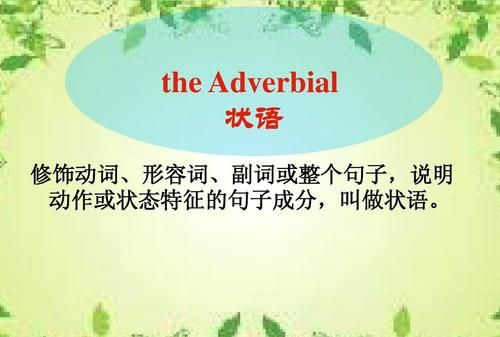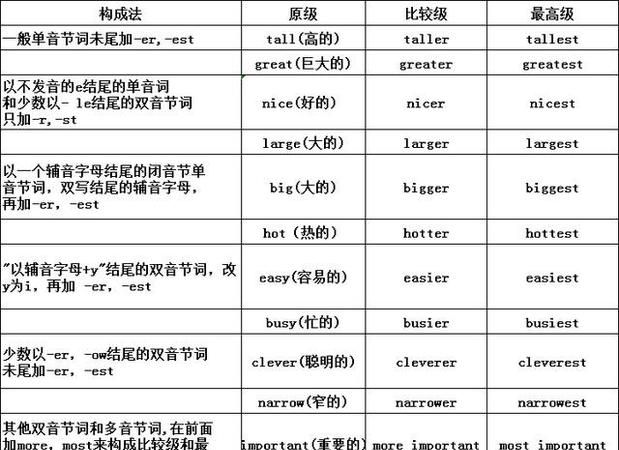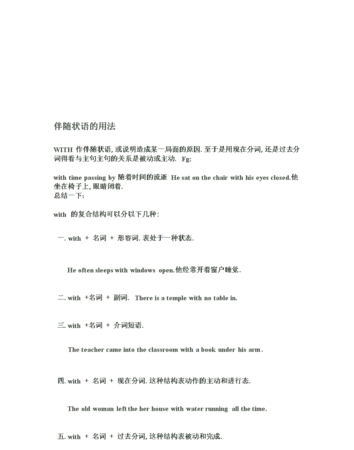本文目录
过去分词什么时候作形容词
主要看前面接了什么介词,for后面就要加doning sth.
形容词做伴随是状语,表状态的,一般有when等介词连接。

形容词作状语
你好!形容词除了可以作定语、表语或补语外,还可以在句中作状语,具有副词的功能。形容词作状语用时,一般用逗号将其与句子的其余部分隔开。这种状语可位于句首、句末或句中。它在意义上相当于一个状语从句,具有以下语义和特征。 一、形容词或形容词短语可以作状语,表示行为方式或伴随状况。有时,它会像非限制性定语从句一样,表示意义上的增补,其逻辑主语是句子的主语。例如: 1. Crusoe stared at the footprint, full of fear. (=Curose, who was full of fear, stared at the footprint. )克鲁索两眼死盯着脚印看,内心里充满着恐惧。 2. He approached us, full of apologies. (=He, who was full of apologies, approached us. )他连声道歉地朝我们走过来。二、形容词或形容词短语可以作状语,表示原因。这种状语一般位于句首,有时也可位于句中。例如: 1. Angry at the girl oversleeping, Mr Green went down to wake her up. (=Mr Green went down to wake up the girl because he was angry with her for oversleeping. )格林先生下去叫醒她,是因为她睡过了头惹恼了他。 2. Lin Tao, glad to accept the suggestion, nodded his agreement. (=Because he was glad to accept the suggestion, Lin Tao nodded his agreement. ) 因为林涛很乐意接受这个建议,所以他就点头同意了。三、形容词或形容词短语可以作状语,表示时间或条件。这种状语通常位于句首,也可位于句末。例如: 1. Ripe, these apples are sweet. (=When / If these apples are ripe, they are sweet. )这些苹果熟了,味道很甜。 2. Enthusiastic, they are quite cooperative. (=When / If they are enthusiastic, they are cooperative. ) 他们热心时是很愿意合作的。四、形容词或形容词短语可以作让步状语。这种状语常由连词or连接的两个或两个以上的并列形容词构成,一般位于句首,有时也可位于句中。例如: 1. Right or wrong, he always comes off worst in an argument because of his inability to speak coherently. (=Whether he is right or wrong, he always comes off worst because of his inability to speak coherently. ) 由于讲话语无伦次,所以不论有理没理,他在辩论中的表现总是非常糟糕。 2. Wet or fine, he got up at six and took a walk in the park. (= Whether it was wet or fine, he got up at six and took a walk in the park. ) 不管是晴天还是下雨天,他总是六点钟起床,并到公园里散散步。五、形容词或形容词短语可以作状语,表示结果或存在的状态。这种状语在句中的位置比较灵活。例如: 1. For a moment she just stood there, unable to believe what had just happened. 她在那儿呆呆地站了一会儿,不敢相信刚才发生的事情。 2. One woman was lying in bed, awake, listening to the rushing wind. 有一个女人躺在床上,毫无睡意,静听那疾驰而过的大风。六、形容词或形容词短语可以在句首作状语,表示说话人的态度。例如: 1. Strange, he should have done such a thing. 奇怪,他做了这样一件事。 2. Worse still, the lion could even carry off the baby it its mouth. 更糟糕的是,狮子甚至能把婴儿叼走 若满意,请采纳!有疑问,欢迎追问!谢谢!

英语中形容词做伴随状语是什么意思
比如:i went home , tired and exhausted ,这个时候 tired 和exhausted就做伴随状语,我回到家,十分累而且精辟历尽,went 是动词,所以形容词就是伴随这个动作而来的

什么是表伴随状态
1. 定义:伴随状语是指状语从句的动作伴随主句发生,它的特点是:它所表达的动作或状态是伴随着句子谓语动词的动作而发生或存在的。
例如:
①He sat in the armchair,reading a newspaper.
他坐在扶手椅里读报。
②All night long he lay awake,thinking of the problem.
他整夜躺在床上睡不着,思考着那个问题。
2. 伴随状语出现的条件
是由一个主语发出两个动作或同一个主语处于两种状态,或同一个主语发出一个动作时又伴随有某一种状态。伴随状语的逻辑主语一般情况下必须是全句的主语,伴随状语与谓语动词所表示的动作或状态是同时发生的。
3. 随状语几种表示方法
一、使用分词形式
The dog entered the room, following his master(这条狗跟着主人进了屋)。
The master entered the room,followed by his dog(主人进了屋,后面跟着他的狗)。
二、用with复合结构
The little girls were playing with snow with their hands frozen red(小女孩们在玩雪,手都冻红了)。
三、用独立主格结构
The little boy goes to school, the little dog accompanying him every day(这小孩每天去上学,那条小狗陪伴着他)。
四、用形容词
Crusoe went home, full of fear(克鲁索满怀恐惧地回家)。
Confident of the victory the players are fighting hard(运动员们对比赛夺胜满怀信心奋力拼搏)。
The match will be broadcast live(这场比赛将作实况转播)。
He left home young and came back old(他少小离家老大回)。
五、用名词
He went away a beggar but retumed a millionaire(他讨吃要饭离家,腰缠万贯回归)。
He who had been twice prime minister of the country, died civilian(他曾两度出任这个国家的总理,而死的时候却是一个平民)。
六、用介词短语
The girl came back to her mother in tears.(这女孩眼泪汪汪地回到母亲身边)。
How can you go to the wedding party in rags(你怎能衣衫褴褛地去参加婚宴)?
I went home out of breath(我上气不接下气地回家)。

以上就是关于形容词表示伴随状态 ,过去分词什么时候作形容词的全部内容,以及形容词表示伴随状态 的相关内容,希望能够帮到您。
